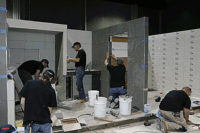What is vapor emission?
A normal concrete slab will emit some degree of moisture as a vapor (gas). This is normal and expected. Vapor will always seek a warmer environment. The concrete slab is a cool environment, and vapor will be driven by capillary action to the warmer atmosphere. In this case, the warmer atmosphere is the inside of the building. The average amount of vapor emitted from the average concrete slab is 3.0 to 4.0 pounds of vapor per 1,000 square feet in a 24-hour period. If vapor emission exceeds 5.0 pounds, tile and stone should not be installed without taken precautionary measures (see below):The concrete slab
To understand why excessive vapor can cause failure, we need to take a look at current construction practices. When concrete is mixed, water is added to aid in workability, making it easier and faster to pour a slab. This excess moisture needs time to escape. This process is called hydration and is a very important part of the curing of the slab. On average, it takes at least 30 days for a concrete slab to cure before any flooring material is installed.
If too much water is added during the slab pour, problems such as excessive moisture can create large capillaries in the concrete. The excess water used requires additional time to cure. With today's fast-paced construction practices, rarely is the slab given sufficient time to cure. The end result is tile failure.
Soluble salts
As moisture migrates toward the surface it will also carry water soluble salts. These salts will often deposit on the surface of the concrete or the stone or between the grout on ceramic tile. This condition is known as efflorescence. These soluble salts have an alkaline pH and are often called alkaline salts. These salts can be measured by taking a pH reading. If the pH is greater than 9, excessive moisture is suspected.The vapor emission test
Before any tile or stone is installed, a vapor emission test should be performed. Recently, ASTM has approved and published a vapor emission test ASTM F-1869. The measurement of vapor emission is a relatively easy task. Calcium chloride is used, due to its high affinity for moisture. A container of calcium chloride is placed under a plastic dome for a 65- to 72-hour period. The container of calcium chloride is weighed prior and after this time period.
The difference in weight gain is recorded and entered into a formula to determine the amount of moisture emitted over a 24-hour period per 1,000 square feet. It is recommended that three tests be prepared for the first 500 square feet, with one test for each additional 500 square feet.
Prepackaged test kits can be obtained from several sources. I buy mine from Vaprecision of Costa Mesa, CA (800-449-6194.) In addition to the test kit, you will also need a gram scale for weighing the test samples.
Here is the procedure for performing the test:
1. Prepare the slab by removing any adhesives, mortar, etc. Use only dry removal procedures. Never use any chemicals. Wire brushing or shot blasting is best. Do not apply the test over expansion joints or cracks.
2. Once the surface is cleaned, remove all loose debris and dust. Take a drop of distilled water and place it on the test area. Place a piece of litmus paper in the drop of water. Compare the color of the paper to the color chart of the pH chart. Record the pH.
3. Take the sealed calcium chloride container and weigh it on the gram scale. Record this weight, as well as the date and time.
4. Remove the tape from the container and open the lid. Do not discard the tape, as you will need it later to re-weigh the dish. I like to place the tape under the plastic dome, so it does not get lost.
5. Place the open container on the slab. Take the plastic dome and remove the cover paper from around the bottom. Place the dome over the container and seat the container's seal by pressing all the way around the outer flange.
6. After 65 to 72 hours, remove the plastic dome. Place the lid back on the container and re-seal it with the tape. Weigh the container and record the results.
7. To calculate how much vapor was emitted, subtract the start weight from the ending weight. This will give you the weight gain. Now enter this figure into the formula noted in Figure 1:
Now What?
Let's say your test results show that the concrete is emitting excessive moisture. What can be done. There are several options:If the concrete pour is new, it simply may need additional time to cure. Wait 30 days and re-run the test. If the concrete is six months or older, then you may have a serious problem. Contact the concrete contractor and try to find out if he used any curing compounds in the pour. Curing compounds can create large capillaries in the slab. Besides tearing up the slab, which can get costly, there are several proprietary vapor emission systems that can be applied. These systems consist of polymers and matting which should be applied by trained individuals. The following is a list of some of these companies:
Sinak Corporation (800-523-3147)
SealFlex (714-708-0850 )
Floor Seal Technology (800-295-0221)
Excessive vapor emission is becoming an enormous problem in areas that use slab on grade construction. Tile and stone setters, as well as general contractors, should be aware of the potential failures this may cause and take remedial steps to avoid these problems.


